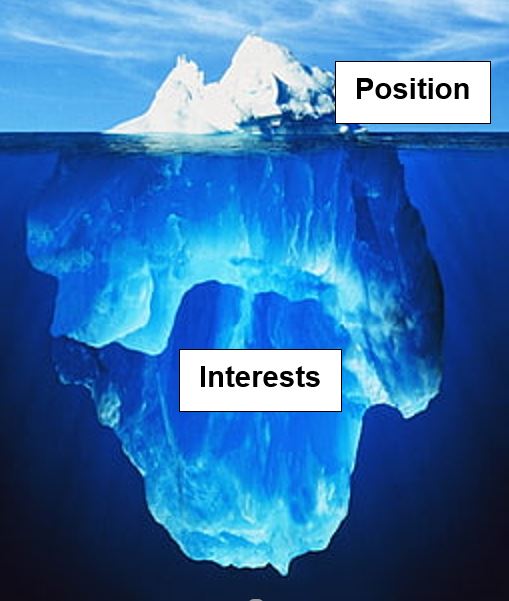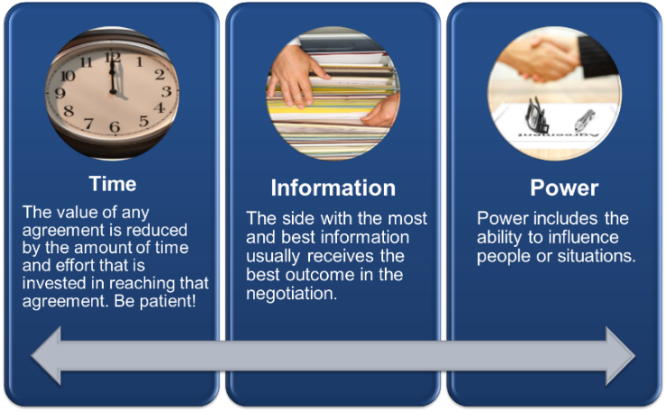On this page:
Negotiating is a Process
Negotiation is a process of getting what you want – “process” being the key element. Negotiation is not so much about the destination as it is the journey. It is a dialogue between two or more people or parties intended to reach a mutual understanding, resolve points of difference, or craft outcomes to satisfy the interests of those involved in the negotiation process. It is the ability to see the situation as the other side sees it and to empathetically understand the power of their point of view and the emotional force with which they believe in it.
For negotiation to be successful, all parties must have a shared understanding of the purpose of the negotiation process and a pre-determined and agreed-upon goal. There also must be an expectation that the outcome of the negotiation will be fair and satisfactory to all and everyone must be willing to modify or change their position in order to meet their goals.
Position vs Interests
There are two key components in negotiation: position and interests. Position is what we say we want; interests are why we want it. We often focus on our positions when we negotiate rather than spending time understanding each other’s interests.
To use a simplistic example, let’s say one person wants the window open and the other person wants the window closed. The position is what each person wants – window open or window closed. So, what do you do? Who wins? Do you compromise so the window is half-open so no one really wins?

But what if we go past our stated positions (window open or closed) and understand each other’s interests? That is, what if we seek to understand why we want the window open or closed?
Perhaps one person wants the window open because they feel it is stuffy in the house and wants fresh air, while the other person is cold and does not want to be in a draft. Now that we know why they want the window open or closed, there is a multitude of possible options for each person to get what they want. We could open a window in a different room, put on a fan, provide a blanket or sweater to the other person, or provide them with a portable heater…well you get the idea. Having a conversation about each other’s interests allows us to have a better, more robust conversation that gets past arguing about whether the window remains up or down to identify options that meet all interests and get to a win-win for everyone.
3 Key Elements
There are three critical elements in any negotiation: Time, Information and Power.
Time: We often focus on getting through negotiation and to win our position in the quickest way possible. However, the value of any negotiated agreement is reduced by the amount of time and effort that is invested in reaching that agreement. Be patient!

Information: The most sucessful negotiation takes prep work. The side with the most and best information usually receives the best outcome in the negotiation.
Power: Power includes the ability to influence people or situations. Without our ability to influence, our negotiation will not be successful. Research suggests that there are generally five to seven types of power: Positional power, reward power, coercive power, referent power, informational power, expert power, and personal power. We often must use our own personal power to influence the other parties in negotiation.
Negotiation Tips
Here are a few tips you can use in your next negotiation effort.
- Try to remain neutral. Our emotions can have a strong, and not always positive, impact on negotiations.
- Be open to hearing the other side.
- Seek to understand the reasons behind their position, that is, their interests.
- Have a full picture of what the other side wants before presenting your solution.
- Use collaborative language, such as “we” vs “I.”
- Remember negotiation takes time and patience.
- Be true to your values.
- Know your BATNA (Best Alternative to a Negotiated Agreement). In other words, if you can’t get to an agreement, what is your next best option?
Look for our upcoming negotiation blog: Negotiation Anyone? Part 2: The Negotiation Process in a Nutshell. This blog will cover the key process steps to a successful negotiation.
For more information on Negotiation, go to https://www.watermarklearning.com/course/negotiation-skills for upcoming classes on Negotiation.

 New Horizons
New Horizons
 Project Management Academy
Project Management Academy
 Six Sigma Online
Six Sigma Online
 Velopi
Velopi
 Watermark Learning
Watermark Learning
 Login
Login




 New Horizons
New Horizons
 Project Management Academy
Project Management Academy
 Velopi
Velopi
 Six Sigma Online
Six Sigma Online
 Watermark Learning
Watermark Learning